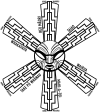Indigenous Māori responses to COVID-19: He waka eke noa?
- PMID: 35527713
- PMCID: PMC9347506
- DOI: 10.1002/ijop.12849
Indigenous Māori responses to COVID-19: He waka eke noa?
Abstract
The COVID-19 pandemic of 2020 has had significant impacts on communities and infrastructures across the globe. Indigenous health experts have called for culturally responsive Government support to mitigate pre-existing inequities and vulnerabilities in Indigenous communities. In Aotearoa New Zealand, official responses to the pandemic typically reflect the worldviews of the settler majority, while Māori interests are treated as part of the national concern. Using autoethnographic, Indigenous voice and an Indigenous wellbeing model, Whiti te Rā, this article contributes insights into Māori cultural values as they were reported in online platforms during the Level 4 lockdown period of March-July, 2020. The authors recorded multiple examples of Māori cultural values and practices that offered individuals, families and communities a digital-social space of safety and hope to build relational resilience, and to mitigate the effects of the COVID-19 lockdown. Observations and responses aligned to the model's six dimensions of relational wellbeing: Māori language, the natural environment, spirituality, creative and performing arts, family (and extended family) values and genealogical connections. The observations highlight that Māori have a multigenerational approach to crisis management based on ancestral wisdom and experience that can inform Government responses.
Keywords: COVID-19; Community responses; Indigenous; Māori; Pandemic; Psychology; Values.
© 2022 The Authors. International Journal of Psychology published by John Wiley & Sons Ltd on behalf of International Union of Psychological Science.
Similar articles
-
Supporting whānau during COVID-19 pandemic in Aotearoa New Zealand: a systems thinking case study.BMC Health Serv Res. 2024 Jun 11;24(1):717. doi: 10.1186/s12913-024-11164-z. BMC Health Serv Res. 2024. PMID: 38858664 Free PMC article.
-
Creating an Indigenous Māori-centred model of relational health: A literature review of Māori models of health.J Clin Nurs. 2021 Dec;30(23-24):3539-3555. doi: 10.1111/jocn.15859. Epub 2021 May 27. J Clin Nurs. 2021. PMID: 34046956 Free PMC article. Review.
-
A tangata whenua (people of the land) approach to conceptualising Māori health and wellbeing.Glob Health Promot. 2023 Jun;30(2):11-18. doi: 10.1177/17579759221130948. Epub 2022 Oct 30. Glob Health Promot. 2023. PMID: 36314287
-
Waka ama: An exemplar of indigenous health promotion in Aotearoa New Zealand.Health Promot J Austr. 2022 Oct;33 Suppl 1(Suppl 1):246-254. doi: 10.1002/hpja.632. Epub 2022 Jun 28. Health Promot J Austr. 2022. PMID: 35714045 Free PMC article.
-
Adapting an equity-focused implementation process framework with a focus on ethnic health inequities in the Aotearoa New Zealand context.Int J Equity Health. 2024 Jan 27;23(1):15. doi: 10.1186/s12939-023-02087-y. Int J Equity Health. 2024. PMID: 38280997 Free PMC article. Review.
Cited by
-
The Impact of COVID-19 on Māori Patients Attending Diabetes Annual Review.Cureus. 2024 Jul 1;16(7):e63571. doi: 10.7759/cureus.63571. eCollection 2024 Jul. Cureus. 2024. PMID: 39087145 Free PMC article.
-
Psychological Resilience among Orang Asli Youths in Selangor during COVID-19 and Its Associated Factors.Malays J Med Sci. 2024 Jun;31(3):204-216. doi: 10.21315/mjms2024.31.3.16. Epub 2024 Jun 27. Malays J Med Sci. 2024. PMID: 38984239 Free PMC article.
-
Decolonizing a Wretched Healthcare System: The African Public Health Practitioner Case.Ethn Dis. 2024 May 27;34(1):49-52. doi: 10.18865/ed.34.1.49. eCollection 2024 Jan. Ethn Dis. 2024. PMID: 38854788 Free PMC article.
-
Supporting whānau during COVID-19 pandemic in Aotearoa New Zealand: a systems thinking case study.BMC Health Serv Res. 2024 Jun 11;24(1):717. doi: 10.1186/s12913-024-11164-z. BMC Health Serv Res. 2024. PMID: 38858664 Free PMC article.
-
Impact of Coronavirus Disease (COVID)-19 on the Indigenous Population of Brazil: A Systematic Review.J Racial Ethn Health Disparities. 2025 May 21. doi: 10.1007/s40615-025-02451-4. Online ahead of print. J Racial Ethn Health Disparities. 2025. PMID: 40397375 Review.
References
-
- Bond, C. , & Whop, L. J. (2020). The answer to indigenous vulnerability to coronavirus: A more equitable public health agenda. The Conversation. https://theconversation.com/the‐answer‐to‐indigenous‐vulnerability‐to‐co...
-
- Cormack, D. , & Paine, S‐J. (2020, 15 May). Dear epidemiology: A letter from two Māori researchers. The Pantograph Punch. https://pantograph‐punch.com/posts/dear‐epidemiology
-
- Cram, F. (2020). Mahi aroha. Aroha ki te tangata, he tāngata. MAI Journal., 9(4), 3–6.
-
- Curtis, E. (2020). An open letter to the government from a Māori public health specialist. E‐Tangata. https://e‐tangata.co.nz/comment‐and‐analysis/an‐open‐letter‐to‐the‐gover...
-
- Duarte, M. E. , George, A. , Deschine‐Parkhurst, N. , & Soto, A. (2021). Caring for our people: Indigenous responses to COVID‐19 era informatic colonialism. AoIR Selected Papers of Internet Research, 20, 1–17. 10.5210/spir.v2021i0.12297 - DOI
Publication types
MeSH terms
Grants and funding
LinkOut - more resources
Full Text Sources
Medical


